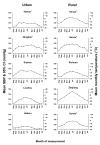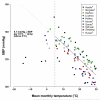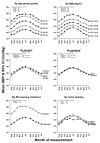Seasonal variation in blood pressure and its relationship with outdoor temperature in 10 diverse regions of China: the China Kadoorie Biobank
- PMID: 22688260
- PMCID: PMC4344838
- DOI: 10.1097/HJH.0b013e32835465b5
Seasonal variation in blood pressure and its relationship with outdoor temperature in 10 diverse regions of China: the China Kadoorie Biobank
Abstract
Objectives: Mean blood pressure varies moderately with outdoor air temperature in many western populations. Substantial uncertainty exists, however, about the strength of the relationship in other populations and its relevance to age, adiposity, medical treatment, climate and housing conditions.
Methods: To investigate the relationship of blood pressure with season and outdoor temperature, we analysed cross-sectional data from the China Kadoorie Biobank study of 506,673 adults aged 30-79 years recruited from 10 diverse urban and rural regions in China. Analyses related mean blood pressure - overall and in various subgroups - to mean local outdoor temperature.
Results: The mean difference in SBP between summer (June-August) and winter (December-February) was 10 mmHg overall, and was more extreme, on average, in rural than in urban areas (12 vs. 8 mmHg; P for interaction <0.0001). Above 5°C, SBP was strongly inversely associated with outdoor temperature in all 10 areas studied, with 5.7 (SE 0.04) mmHg higher SBP per 10°C lower outdoor temperature. The association was stronger in older people and in those with lower BMI. At lower temperatures, there was no evidence of an association among participants who reported having central heating in their homes.
Conclusion: Blood pressure was strongly inversely associated with outdoor temperature in Chinese adults across a range of climatic conditions, although access to home central heating appeared to remove much of the association during the winter months. Seasonal variation in blood pressure should be considered in the clinical management of hypertension.
Figures




Comment in
-
Seasonal variations in blood pressure: a complex phenomenon.J Hypertens. 2012 Jul;30(7):1315-20. doi: 10.1097/HJH.0b013e328355d7f9. J Hypertens. 2012. PMID: 22706390 No abstract available.
References
-
- Wang L, Kong L, Wu F, Bai Y, Burton R. Preventing chronic diseases in China. Lancet. 2005;366:1821–1824. - PubMed
-
- Prospective Studies Collaboration. Age-specific relevance of usual blood pressure to vascular mortality: a meta-analysis of individual data for one million adults in 61 prospective studies. Lancet. 2002;360:1903–1913. - PubMed
-
- Khaw KT, Barret-Connor E, Suarez L. Seasonal and secular variation in blood pressure in man. J Cardiac Rehabil. 1984;4:440–444.
Publication types
MeSH terms
Grants and funding
LinkOut - more resources
Full Text Sources

